‘Credit where credit’s due. Yuka brought the first Chinese records home which filled my head with unknown sounds, and it was only a matter of weeks before they were circulated around the band and we were all hooked,’ writes Mick Karn in his book Japan & Self Existence of then girlfriend, Yuka Fujii. ‘I couldn’t get enough of them. It was always exciting to get home and listen to what I’d bought on the strength of the sleeve design alone. The best were the instrumental tracks, for it was the unusual instrumentation that left us wondering at how the absence of guitars, drum kit, synthesisers and anything else familiar, somehow still produced commercially driven music.
‘The direction that had been missing for the next album was now beginning to take shape. Without consciously copying or mimicking anything we heard, but simply by exploring our own western, electronic instruments to interpret and blend the newly found influences into our writing. We listened to nothing else.’
And it wasn’t just the music that appealed. ‘Yuka had become obsessed with all things Chinese, and excitedly showed me around the alleyways of Chinatown filled with the small shops she’d discovered, selling knick-knacks, unusual prints and ceramics that must have looked relatively normal to anyone Chinese. The bold use of colour and painted posters as opposed to photos, the strange kitchen utensils, military costumes, martial arts accessories, she knew it would appeal to me…But the best, and by far the most influential finding, was the music.’ (2009)
‘At the time we started writing the album material we were into finding and listening to Chinese traditional music,’ Sylvian confirmed in a radio interview to mark Tin Drum‘s release. ‘And because it was that time when we were interested in it, we started writing material around it. We’ve always been interested in Japanese traditional music and Asian music. Had we started writing the material at any other time, it could have been based on a different type of music, but it just happened to be at that point in time.’
The sound world of those treasured vinyls which passed between the band members provided a template for the feel of their new project. Sylvian said they were looking for ‘not so much oriental as acoustic sounds. I didn’t want the whole album to come over really synthetic, because that comes over too cold. It was to try and make the overall sound acoustic-sounding even though the whole album is based on keyboards…
‘Every sound that went down was treated in some way. Every sound had to be thought about because it’s such a sparse sounding album. Normally we work in building up textures, layers of sound, and this one’s basically the bare essentials, so every sound had to be thought about and then treated.’
The meticulous work of Richard Barbieri and David Sylvian in programming unique keyboard sounds for Tin Drum is widely celebrated but ‘Visions of China’ also exhibits outstanding work by Steve Jansen in using acoustic drums, supplemented with synthesised overlays, to provide a brilliantly innovative and descriptive expression of rhythm that was perfect for the atmosphere being evoked.
‘With songs such as ‘Canton’ and ‘Visions of China’ the drums were driving the structuring of the tracks,’ Steve recalled. ‘‘Visions of China’ was a late addition to the album and was worked on into the night at a studio in Swiss Cottage towards the end of recording the album…
‘I would like to deviate from the instinct to play regular patterns because otherwise it would make the song sound too “normal”,’ Jansen explained. ‘Mick too. I think especially with Tin Drum, if you subtract the performances and put a straight rhythm section (bass and drums) behind those songs it would all fall rather flat. The tracks were structured to accommodate performances and fairly intricate arrangements. It was very much a musician’s album.’ (2017)
‘I wanted to design rhythms that didn’t use hi-hat or ride cymbals, without losing momentum.’ The practical challenge for the drummer was a significant one. ‘Those particular tracks were not recorded in part, they were played as whole takes and in those days you had to get through the entire track without any mistakes… unless there was an obvious drop-in point (such as the pauses in ‘Visions of China’). Speaking of which, for the drum break in that song I overdubbed separate synth percussion parts on the Prophet 5 to augment the basic pattern and give the impression of multiple drummers.’ (2015)
Additional snares were also added afterwards. The combined impact is a drum part so memorable that we can probably all hear it in our minds as we read this. Intricate, yet powerful. Reminiscent of stately ceremonial drumming, but somehow supremely fitting for this ’80s pop song.
When hosting one of Tim Burgess’ twitter listening parties in 2021 to mark the upcoming 40th anniversary of Tin Drum, Jansen shared some insights from his recording diary and image archive relating to the song (dates mentioned are from 1981):
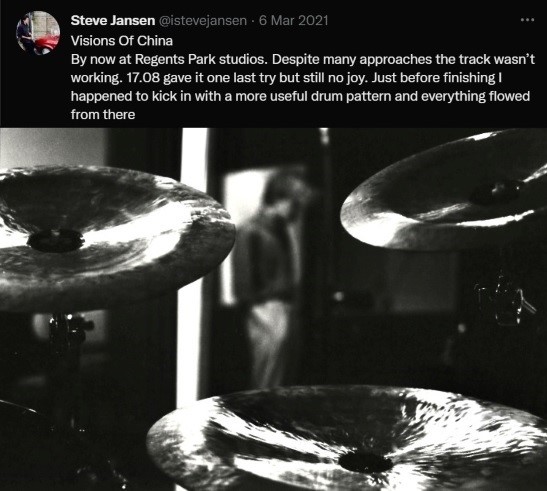
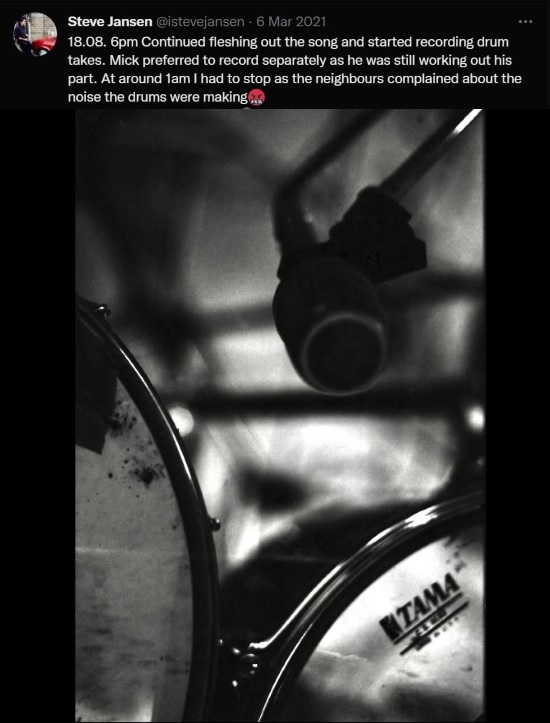

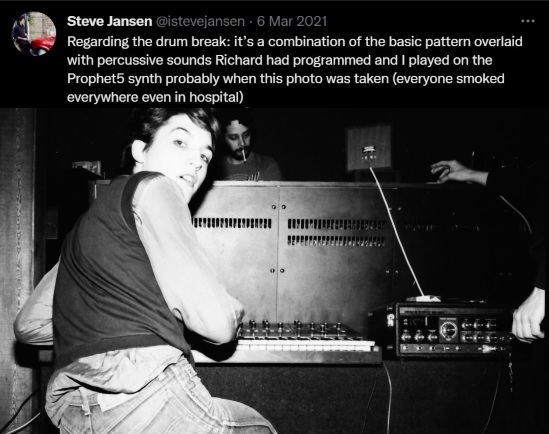
Richard Barbieri: ‘The percussion is quite dominant because we wanted a lively sound, and we used a new producer [Steve Nye] as opposed to John Punter who worked on Quiet Life and Gentlemen Take Polaroids and who’s doing the live sound for our tour. John’s been involved in about half our music, but on Tin Drum we were looking for a different sound, a hard acoustic sound with a sort of “dead echo” using single repeats as opposed to a lot of echo or reverb. There’s no reverb in Chinese music!’ (1983)
Listening again with Richard’s observation in mind, it is so clear that this “dead echo” is a signature characteristic of the album’s sound.
Steve tells us that the vocal was recorded on 27 August 1981, with mixing taking place at Air Studios a month later on 28 September. This was two days before the final track was mixed – ‘Ghosts’ – and the album tapes finalised.
Whilst recording was underway, photographic sessions were held for the cover artwork of Tin Drum. ‘Fin Costello was to provide the creativity,’ recalled Mick Karn, ‘although most of it came from already established ’50s photography taken in China. We looked through some books he’d found and chose what we thought were the best shots that he planned to recreate together with anything Chinese from my flat’ (2009). The front cover was shot at Costello’s studio on 5 August with the rear cover pictures taken on 8 September. The inspiration for the cover art was found in a newly published volume by Marc Riboud containing his photos taken in China during the period 1957-1980. The book was titled Visions of China, and Steve Jansen’s Tin Drum timeline confirms that the band were very familiar with its contents when their track of the same name was being constructed, leaving little doubt that it inspired the song title too.

In our modern globalised world it’s easy to forget how unfamiliar China was at this time, even if things were beginning to change. It really was a land of mystery. Riboud wrote in the introduction to his Visions of China, ‘To understand how the Chinese think and feel is so difficult that I leave the subtle art of analysis and commentary to others. The best way to discover China is perhaps to use one’s eyes. Intense attention to detail and to the moment, here more than elsewhere, can lead to knowledge and understanding.
‘For so long, and until so recently, China was a closed and secret land where the huge transformations taking place were almost always hidden from foreign eyes. Today the doors are opening. Visitors are flooding in. After a first impression of uniformity, of omnipresent poverty, they discover a mosaic of images where past and present, centuries-old traditions and the grip of the Party, are superimposed like double and triple exposures, rarely harmonising, constantly clashing.’
Flipping the pages of Riboud’s monochrome images, the band evidently found the visual stimulus to match their fascination with the sounds discovered on obscure LPs picked up in London’s back-streets.

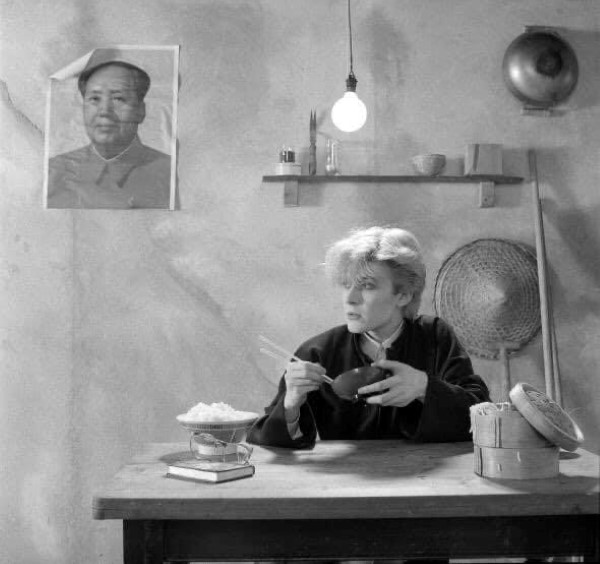
Asked about the picture on the reverse of the album sleeve, Sylvian said, ‘That was more the idea of being on trial. It’s taken from a still of a picture taken in China in a divorce case, and we put the whole idea together: built the room, built the set. It’s meant to be based in China.’


Steve Jansen recently shared that the concept for the rear cover portrait was that the band-members were ‘aliens in China’. He also confided that the picture ultimately used was from a re-visit to Fin Costello’s studio the day after the original session. ‘We had a re-shoot next day purely for the purposes of toning down Richard’s “doctor” image which was deemed a little too farcical since the rest of us weren’t really looking “in character”.’ (2023)
Some images from day one have emerged, showing Barbieri in white suit, bow tie, and clutching a leather medical bag:
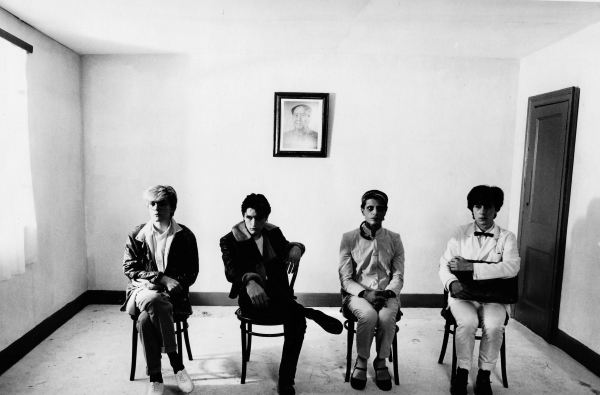
Sylvian’s lyric is oblique as was typical at the time: a series of images wide open for the interpretation of the listener. Does it approach the subject from the perspective of someone living in China, or as an outsider looking in – perhaps someone seeking to understand their own life by observing the vastly different circumstance of others?
The opening verse appears to articulate the imagined standpoint of a Chinese citizen. Just as the West had an incomplete understanding of the realities of life in China, so someone living in the country lacks a wider outlook by which to judge their life experience.
‘I’m walking young and strong
But just a little too thin
I may be happy, but I haven’t a clue
To this life
In my mind’
There is a sense of duty to the fatherland that every young man should have, but is this created through an establishment projection of the truth that obscures reality?
‘Stay with me
We could learn to fight
Like every good boy should
Cling to me
We are blacked out
In visions of China tonight’
I’ve often thought that the second verse might express the kind of fascination with another culture that the band were caught up in: one that can only scratch the surface through distant eyes. Maybe it works two ways as very different cultures gaze at one another with deep curiosity: East looking to West and vice-versa?
‘I’m building heroes again
I never thought of before
I remember the fashion, but don’t have a clue
To your life
In my mind’
Some have suggested that Tin Drum romanticises communism as the basis of an ideal society. It seems to me more likely that this song depicts people caught in a system that allows neither individual progression nor expression, a regimented self-perpetuating order of things.
‘We walk backwards, say nothing
My visions of China
We’re young and strong in this party
We’re building our visions of China.’
‘It’s playing with images, but in a tongue in cheek way,’ said Sylvian. ‘‘Visions of China’ is about people using an image and knowing nothing about the culture, which is something that all pop music is involved in and it’s a vacuous lie, it’s superficial and it means nothing.’ (1986)
The truth is that none of the band members had visited China at this time and their own relatively recent fascination could not hope to embrace the complexities of the tumultuous years of the Cultural Revolution so recently ended. Theirs was not purely an adoption of image for its own sake, and it certainly wasn’t a cynical ploy designed to endear them to the record-buying public, but the band no doubt ran the risk of themselves standing accused of lacking real substance.
‘Visions of China’ was released as a single in October 1981, less than a month after mixing was completed, with Tin Drum following in November. It was accompanied by a promotional video laden with imagery from the East. The black and white opening scene shows Sylvian seated on the floor watching a TV set. It immediately brings to mind another photograph from Marc Riboud’s book, this time showing a young couple proudly carrying a new television through the streets of Peking in 1979, a purchase that the photographer states would have cost them a year’s wages. It seems to be a symbol of a society opening up – but this modernisation could equally herald a new and more effective phase of state communications…
In the video we see the traditional lion dance that graces the celebration of Chinese New Year and other significant festivals; Steve Jansen and Richard Barbieri sit cross legged on the floor playing chess whilst dressed in Chinese military uniform; the scene shifts to Mick Karn – similarly attired – playing the dida, a Chinese double-reeded instrument also known as the suona; two men fight with traditional weapons; the band recreate a pose with red flag that is reminiscent of familiar painted propaganda posters… Steve Jansen’s epic drum solo is accompanied by archive footage of Chinese soldiers marching purposefully and their impassioned pronouncement of some order or oath of allegiance. The narrative device that frames the promo starts with the lighting of a gunpowder trail which ultimately causes the obliteration of Chairman Mao’s image as the final act. It was in 1981 that the Chinese Communist Party declared that Mao’s Cultural Revolution caused ‘the most severe setback and the heaviest losses suffered by the party, the country, and the people since the founding of the People’s Republic.’
As we see Sylvian for the last time, the simple jigsaw he has been completing is revealed to be the picture of an Asian woman, the reference apparently more Japanese than Chinese, and monochrome turns to technicolour as the light of a wider world floods in.
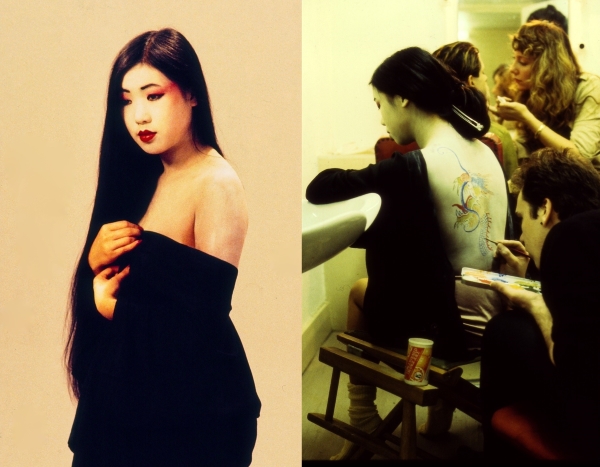
Twenty-first century sensibilities may cry cultural appropriation at this melting pot of adopted Eastern imagery and sounds. Indeed, at least one academic paper has described Japan’s weaving of both musical and visual influence from China into their work as ‘problematic’.
‘At that time I hated the way Eastern music was always used as a gimmick,’ Sylvian has stated. ‘It was never taken seriously in pop music. We wanted to introduce it more seriously, though ours too did verge on the gimmicky side – in ‘Visions of China’ for example. We were aware of that at the time. We weren’t sure how far we could take it. For some people it would be over the borderline, for others it would be just on the edge.’ (1984)
Personally, I see four young musicians with a genuine fascination for the East borne not least from their own travels to Japan and personal interactions with Japanese musicians. The ‘Visions of China’ video was created in the early days of such music promos that experimented with the presentation of something other than a band performing their song, and it is executed with far less artistry than the music itself. It would be fair to assume that many of the images included were chosen purely for visual appeal and without an appreciation of the weight of some of the undertones as China emerged from an extremely bloody era in its history. But then it could be argued that this is what the song is about – both Western ‘visions of China’ at the time and the imagined ‘visions of China’ from the perspective of someone who lives there.
With the benefit of the hindsight of four decades, Steve Jansen doesn’t look favourably on the video, citing that is was ‘conceptually so confused (typical ’80s)’ and employed a ‘far too unsubtle use of Chinese themes/clichés.’ In particular, to present the band in military uniforms was a ‘poor decision’, his reflection being that they ‘probably should have attempted to follow up with the concept of “aliens in China” as on the rear cover of Tin Drum.’ (2023)
As a package it is unquestionably superficial at one level – impressions of a much more complex reality – but I don’t doubt that the inspiration from the music and culture was real, and that Japan’s incorporation of what they had heard into their own art was sincere. After all, the history of music across many genres is a story of influences transcending geographical borders to create new and exciting sounds. With ‘Visions of China’ and Tin Drum, Japan certainly innovated in sound and did so with a high degree of technical ingenuity.
‘Visions of China’
Richard Barbieri – keyboards, keyboard programming; Steve Jansen – drums, percussion, keyboard percussion; Mick Karn – fretless bass, dida; David Sylvian – keyboards, keyboard programming, vocals
Music by Steve Jansen and David Sylvian. Lyrics by David Sylvian.
Produced by Steve Nye & Japan. From Tin Drum, Virgin, 1981
Lyrics © samadhisound publishing
Download links: ‘Visions of China’ (Apple)
Physical media links: Tin Drum (Amazon)
Full sources and acknowledgments for this article can be found here.
Steve Jansen has a range of photographic prints available for sale at his website here, including shots from the recording of Tin Drum and the ‘Visions of China’ video. These are always meticulously reproduced.
The Tin Drum twitter listening party hosted by Steve Jansen can be replayed by visiting this link.
‘Leading up to this album, everything we were doing was Chinese orientated. Not purposely…it just seemed to be that way.’ Steve Jansen, 1981

More about Tin Drum:
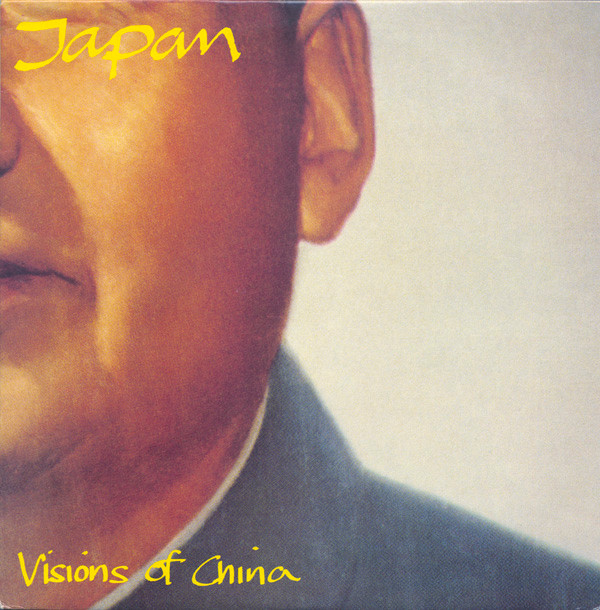
I remember no one in my teenybopper group had any idea what to make of it! You certainly couldn’t skulk around the dancefloor of Sunderland’s Heroes nightclub with your cider and blackcurrent to it, shaking your backcombed mop! It was an utterly opaque entity. Akin to the scene from Kubricks Space Odyssey where the object appears to the apes. We were going to have to…..learn something!
LikeLiked by 1 person
Of course, the peak of the creative unit, that was and still is (on record), Japan. The Chinese influence also made the group interesting; one wouldn’t expect a group called ‘Japan’ to be evoking all things Chinese. The reference to Chinatown, reminds me of ‘my London period’ (1995-2001), thanks for reminding me, VB. Outside the group, Andy Mackay was dressing similarly, in the period, 1979-81 (I saw him in January 1981, in Manchester, in such attire).
The work was prophetic too, China has grown as a world power, since Japan’s ‘Visions of China’.
Thanks for the article that must also include some of the late, for me great, Mick Karn’s later quotes ‘(2009)’, for instance. The photos are great. England too, was a very different place, in 1965 and 1971. ‘In my mind…/In your mind…’ (former, Sylvian, 1981, latter, Ferry, 1977, both involving, Steve Nye). I’ve said this before, I think, somewhere herein, but the dawn of the 1980’s (in pop) carried on the ever-changing momentum of the 70’s with optimism, and it was very exciting…
LikeLiked by 1 person
When a pop song became melancholic…makes me wonder.
LikeLike